
Take steps toward a healthier planet this Earth month by choosing eco-conscious for your facility
State and local governments have been pushing for organizations to use eco-conscious products. In fact, 76% of U.S. states have an environmentally preferable purchasing (EPP) policy, and of these states, 90% were enacted in the last 15 years. Despite this, eco-conscious cleaning product adoption lags. In fact, while three out of four cleaning professionals agree that eco-conscious cleaners and disinfectants are important to use, 67% still have uncertainties about making the switch. A common misconception is that eco-conscious cleaners and disinfectants are less effective and efficient than traditional cleaners.
Research proves that an eco-conscious disinfectant kills germs as effectively as traditional products
Trusted certifications, such as EPA Design for the Environment (DfE) require product manufacturers to prove that their products are as effective as traditional products in addition to meeting stringent criteria for efficacy and effects on human health and the environment. We wanted to prove the disinfecting efficacy of the DfE-certified, lactic acid-based disinfectant Clorox EcoClean™ Disinfecting Cleaner against several traditional disinfectant actives: sodium hypochlorite (bleach), quaternary ammonium chloride (quat), and hydrogen peroxide. We tested each product against 6 viruses (SARS-CoV-2, Norovirus, Rhinovirus, Respiratory Syncytial Virus (RSV), and Hepatitis B virus) and 4 bacteria (Methicillin-resistant Staphylococcus aureus (MRSA), Pseudomonas aeruginosa, Streptococcus pyogenes, Staphylococcus aureus). We followed EPA testing requirements for determining microbicidal efficacy against each bacterium and virus and determined how much time was required to kill 99.9% of the viruses and bacteria tested.
Here's what we found: The Clorox EcoClean™ lactic-acid based disinfectant effectively killed 99.9% - viruses and bacteria in under 2 minutes, including the harder to kill pathogens norovirus and rhinovirus. Overall, when following the directions for use and contact time, EPA DfE-certified disinfectants are effective.
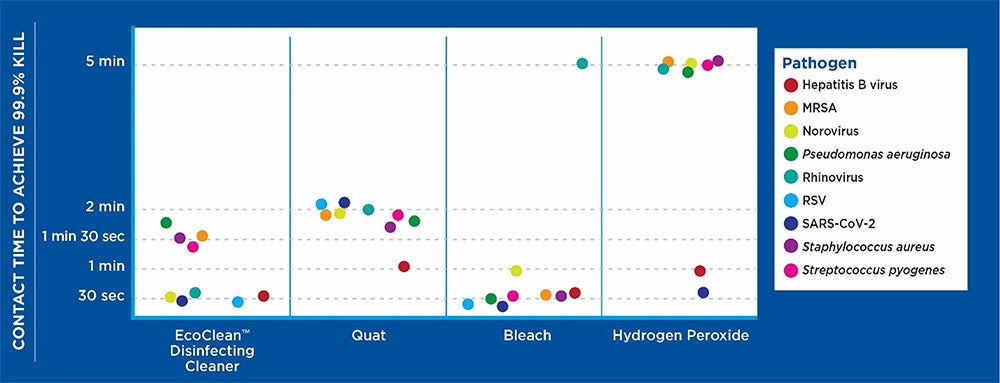
Making eco-conscious choices benefits people today
People often emphasize the reduced impact on the environment when talking about eco-conscious products. But eco-conscious products can also provide immediate benefits to the people that use them.
- For janitors: Eco-conscious products are often made with no dyes, fragrances, and don’t require PPE to use.
- For building occupants: Eco-conscious products work just as well as traditional products but often have fewer odors or irritating smells.
- For your bottom line: Ready-to-use, eco-conscious products with fast contact times can actually save facilities time and, in a separate study, could save up to $1 per classroom versus traditional concentrates. Fast, ready-to-use products save time on mixing and disinfecting.
There has never been a better time to switch to an eco-conscious product
With so many effective options now available, there’s no time like this Earth Month to make the change to an eco-conscious product to benefit your facility. Learn more about CloroxPro’s commitment to sustainability
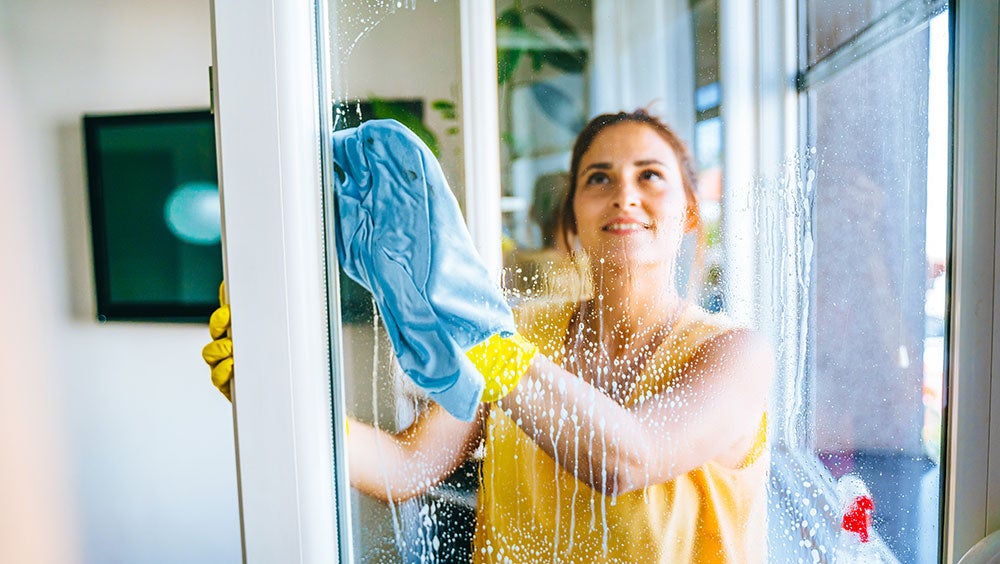
If you’re responsible for keeping a facility looking clean, you know that keeping glass windows and mirrors dry and without streaks is critical. But perhaps you have wondered why you need a special cleaner for glass. A bit of residue or streaking may go unnoticed on some surfaces, but on glass, streaking or residue left behind is obvious and makes surfaces look dirty. When cleaning glass, it is important to have a product that evaporates quickly to prevent visible residue from forming on the surface. Traditional water-based cleaners are more focused on removing soils, grease, and grime and are great on many surfaces, but when used on glass, they can leave water marks and streaks.
Components of a typical glass cleaner
Because glass and mirrors have unique needs, products used to clean these surfaces should do three things:
- Wet the surface well.
- Clean the surface.
- Evaporate quickly to leave a streak free shine.
All-purpose cleaners tend to remove soils and wet surfaces well, but do not typically evaporate quickly. Also, traditional cleaners often have added fragrances to provide a pleasant scent.
Glass cleaners on the other hand are made with different ingredients that make them work especially well on shiny glass and mirrored surfaces:
- Solvents. Glass cleaners contain high levels of solvents, such as ammonia and alcohol, that evaporate quickly and are less likely than water to leave streaks.
- Surfactants. These are the cleaning ingredients that remove grease, grime, and dirt from surfaces. Glass cleaners usually have lower levels of surfactants than traditional cleaners to avoid leaving residue on surfaces.
- Glycerin. Glycerin is a compound that can help wet the surface evenly. All-purpose cleaners do not need glycerin because they are water-based which already wets surfaces well.
- Fragrance. Added fragrances are important for leaving a pleasant smell, but fragrances tend to be oil-based, which can leave streaks and residue on surfaces. That’s why glass cleaners tend to have low or no fragrance added.
The overall formula and relative amounts of each ingredient are distinct to each product and contribute to how well a product works.
Ammonia in glass cleaners — a necessary evil or just unnecessary?
Ammonia is an effective solvent in glass cleaners because it evaporates quickly and is less likely to leave streaks. However, ammonia may cause respiratory irritation among more sensitive populations and can become dangerous if mixed with chlorine-containing products1. While ammonia-based cleaners are safe when used as directed, it can provide peace-of-mind to facility managers to find a glass cleaner that is made with ingredients that pose fewer risks related to accidental mixing, skin contact, or inhalation. There are ammonia-free glass cleaners available that are just as effective at cleaning, while being a better choice for front-line cleaners and janitors.
Looking for an ammonia-free glass cleaner? Look for the EPA Safer Choice seal. Safer Choice certification requires cleaning products to meet high standards for human health and the environment, and under these standards, ammonia is not an acceptable ingredient.
Choosing an ammonia-free glass cleaner without sacrificing efficacy
Efficacy as a glass cleaner is measured based on a standard streaking test that rates products 1-4. The gold standard glass cleaner achieves a “streak free” rating, or 4/4 on the streaking tests. Under the EPA Safer Choice program, cleaning products must show performance comparable to traditional products. Per the Safer choice Standard2, a glass cleaner meets certification requirements for efficacy if it achieves at least 3/4 on the streaking and residue tests.
So look for the Safer Choice certification to find a glass cleaner that really works, without the downsides.
Find Safer Choice Certified glass cleaners
To find a Safer Choice Certified glass cleaner for your facility, follow the link below and sort product type for window/glass cleaners.
https://www.epa.gov/saferchoice/products
References
1. The Facts About Ammonia [Internet]. Available from: https://www.health.ny.gov/environmental/emergency/chemical_terrorism/ammonia_general.htm#:~:text=Exposure%20to%20high%20concentrations%20of,and%20nose%20and%20throat%20irritation.
2. Safer Choice Standard and Criteria [Internet]. Available from: https://www.epa.gov/saferchoice/standard
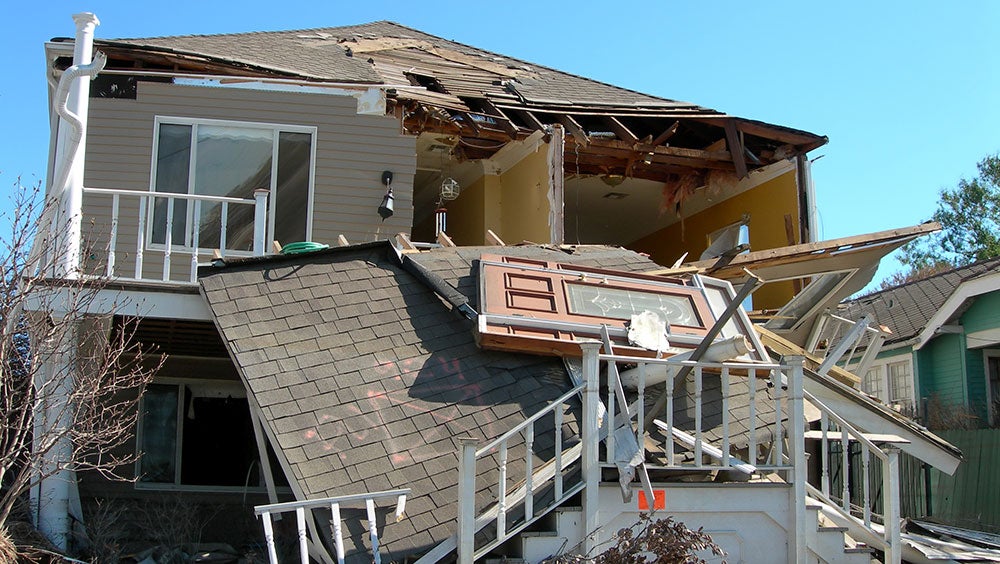
The Misconception of Disinfectant Resistance: Answering This Question I Received at ISSA 2023
At the annual International Sanitary Supply Association (ISSA) in November, I presented a thought leadership session on sustainability and how eco-conscious disinfectants can be as effective as traditional. Talking to people after my presentation I heard the same question several times: “How often would I have to switch disinfectants to make sure the pathogens don’t become resistant to them the way they become resistant to antibiotics?” Rotating sanitizers is sometimes still practiced in food processing and in pharmacy compounding, but there are different reasons those places may want to do this that don’t apply broadly. While my colleague addressed pathogen resistance to disinfectants in a previous blog, I want to focus on the differences between antibiotic resistance, immune evasion and disinfection resistance.
Antibiotic Resistance, Immune Evasion, Disinfectant Resistance
Because of the COVID-19 pandemic, we have become familiar with news headlines about viruses evolving to evade our immune system. Additionally, we see lots of scary news coverage about antibiotics not working against common bacteria anymore. It is easy to feel like surface disinfectants would be no different.
To help explain antibiotic resistance, immune evasion, and disinfectant resistance, first imagine that pathogens are like a house. The house has certain functions: the stove and oven to cook food, the doors and windows have locks to keep bad things out and good things in, the bathroom fixtures and plumbing system to eliminate waste. All these things need to work for the house to do its function.
We have developed ways to prevent bacteria and viruses from performing their functions: our immune systems fight them off, and we have antivirals and antibiotics to help where our immune systems cannot handle it alone. But bacteria and viruses have evolved their own protections as well.
Antibiotic Resistance: Finding a Workaround to Something Broken

Antibiotics work by breaking something crucial for the bacteria’s survival. Bacteria need to be able to make proteins to build their walls, they need to eliminate waste, and they need to process nutrients. Antibiotics come in and break one part of it. But in certain cases, bacteria have evolved resistance to antibiotics that can help them remove or inactivate the drug. This would be like breaking your oven. This would prevent you from making some food. But if you were resistant, you could easily fix the oven or remove whatever was keeping it from working and continue functioning as normal.
Immune Evasion: Like Changing the Locks
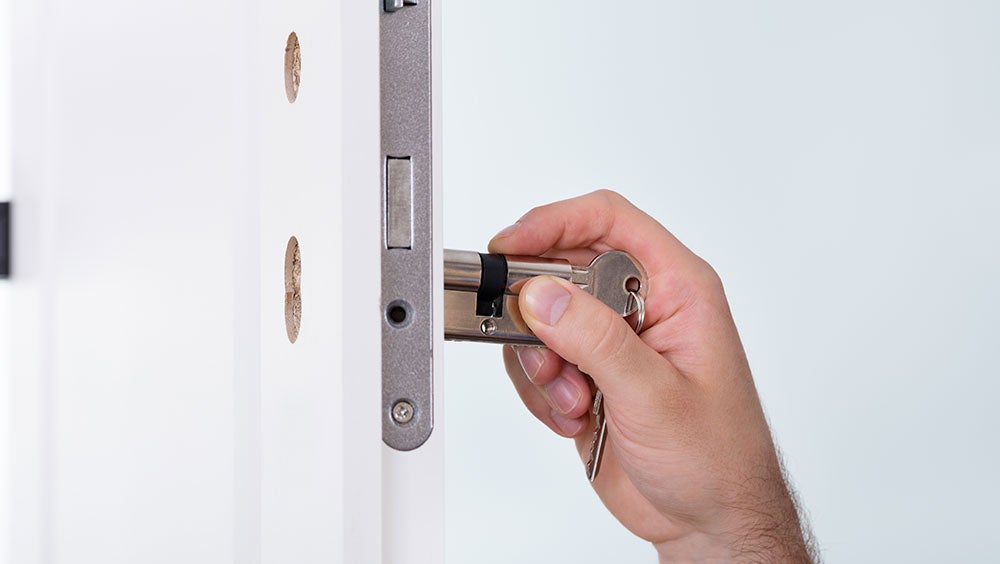
During the COVID-19 pandemic, we became familiar with terms like “immune evasion” to describe new variants of COVID-19 that our immune systems could not recognize. The immune system generally recognizes proteins on the outside of a pathogen — things on the surface. Immune cells have receptors that fit the proteins on a virus like a lock and a key. Once the immune cell binds to the virus, it can open it up and get inside, killing the virus. A virus like COVID-19 can easily change the shape of a protein on the surface to avoid the immune system. Basically, the virus can change the locks on the house and the immune system takes a while to make a new key.
Disinfectants Destroy the Whole House
I have now explained how antibiotics work to kill bacteria, and how the immune system works to kill viruses. What both of these have in common is that they are highly specific. The immune system recognizes viruses using very specific receptors, like a lock fits a key. Antibiotics work by targeting very specific pieces of bacterial function — like penicillin prevents bacteria from tying proteins together. Bacteria can evolve mechanisms to break down penicillin, and viruses can evolve their structure so that the immune system key doesn’t fit the lock anymore.
Disinfectants, by contrast, are not specific. They broadly destroy the structures of pathogens and have multiple targets and multiple sites of action. To use the house analogy, a disinfectant will blow holes all over the walls and roof until the whole house collapses. There is no way a pathogen can evolve to protect themselves from that. If you want to learn more about how different types of disinfectant active ingredients work to destroy pathogens, I cover the different mechanisms in this blog.
There Is No Need to Rotate Disinfectants — Follow These 3 Tips to Disinfect Properly
Now to return to the questions I received at ISSA 2023. There is no need to rotate disinfectants to prevent resistance! What is most important is to use a disinfectant properly:
- Follow the instructions for use on the label. Some products require you to pre-clean the surface before disinfecting.
- Choose a disinfectant that can kill the pathogens you are concerned about.
- Leave product visibly wet on the surface long enough to meet the contact time. Products with a contact time of 2 minutes or less make it easier to disinfect without needing to re-wet the surface.

The Green Chemistry Challenge Awards promote the environmental and economic benefits of developing and using novel green chemistry. In recent years, manufacturers in the cleaning industry have started making their mark for greener chemistry. 2021 was the first year of the Green Chemistry Challenge that a cleaning industry manufacturer won the Design of Greener Chemicals Category. Since the awards inception, only two manufacturers have won the award for developing consumer available cleaning and disinfecting products: Colonial Chemical for Suga®Boost surface cleaner, and the Clorox Company for Clorox EcoClean™ Disinfecting Cleaner.
Reducing the Hazards of Designing, Manufacturing, and Using Chemicals
The EPA started the annual Green Chemistry Challenge in 1996, and for the past 26 years, EPA has awarded 133 winners out of 1,800 nominations. To win, companies and academic institutions must demonstrate that their product or process has scientific merit, provides human health and environmental benefits, is practical and has great impact. Ultimately, this program advances EPA’s goal to significantly reduce the hazards associated with designing, manufacturing, and using chemicals. Among these accomplishments, winners of the Green Chemistry Challenge have contributed to1:
- Eliminating 830 million pounds of hazardous chemicals and solvents every year. This is equivalent to removing 3,800 railway tank cars every year.
- Saving 21 billion gallons of water each year — the amount of water used by nearly 1 million people annually.
- Eliminating 7.8 billion pounds of carbon dioxide equivalents from entering the air each year. This is the same impact as removing 770,000 vehicles from the road each year.
Recognizing the Winners of the 2023 Green Chemistry Challenge
Below are the winners of the 2023 Green Chemistry Challenge and a brief description of the product they developed. Congratulations to the winners and thank you to the EPA for leading this awards program2!
- Design of Greener Chemicals: The Clorox Company for Clorox EcoClean Disinfecting Cleaner, a Design for the Environment-certified disinfecting cleaner that can be used without personal protective equipment, is formulated without alcohol and disinfects 99.999% of illness-causing germs in 2 minutes or less.
- Academic Category: University of Michigan, Ann Arbor for developing new ways to refind common agricultural waste into materials that can be used in lithium-ion batteries.
- Greener Synthetic Pathways: Solugen for developing the Bioforge™, a chemical manufacturing platform that converts plant-derived substances into a range of materials that have historically been made from fossil fuels, without resulting emissions or waste.
- Greener Reaction Conditions: Captis Aire LLC for the CAIRE technology that captures more than 90% of terpenes, a waste product from the wood manufacturing process, and converts it into valuable chemicals including those used in products such as biofuels, flavors, and fragrances.
- Small Business Award: Modern Meadow for developing a more efficient textile dyeing process called the Bio-FREED™ Powered by Bio-Alloy™ which uses a bio-based protein foam to dye any type of fiber.
- Specific Environmental Benefit — Climate Change: Air Company for developing a technology that mimics photosynthesis to transform the greenhouse gas carbon dioxide into other organic chemicals, producing oxygen as the only byproduct.
Check Out my Latest Webinar from ISSA
Learn more about Clorox EcoClean™ and how it can provide fast and efficient disinfection.
References
1. Information about the Green Chemistry Challenge | US EPA [Internet]. www.epa.gov. [cited 2023 Oct 25]. Available from: https://www.epa.gov/greenchemistry/information-about-green-chemistry-challenge
2. EPA announces winners of the 2023 Green Chemistry Challenge Awards [Internet]. www.epa.gov. [cited 2023 Oct 25]. Available from: https://www.epa.gov/newsreleases/epa-announces-winners-2023-green-chemistry-challenge-awards
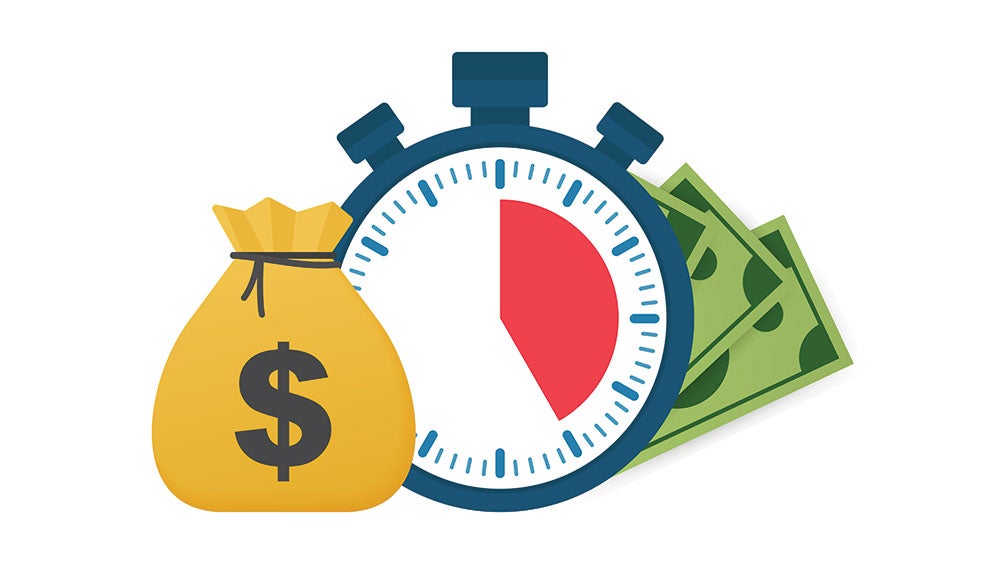
How Disinfection Contact Time is Determined – And Why It is Critical to Keep the Surface Visibly Wet
Anytime you pick up a disinfectant and read the instructions for use, you will see a contact time. This is the proven time a disinfectant product is effective against bacteria and viruses. Usually, the label instructions say something like this: “Spray the surface. Allow surface to remain visibly wet for 2 minutes.” The words “visibly wet” have created some debate about proper use; but simply put, disinfecting products must remain on a surface for the listed contact time. After the contact time has been reached, you can wipe away excess liquid with a clean cloth.
To understand why, it is important to know how products are tested for disinfection.
The Environmental Protection Agency (EPA) requires that disinfectant products are tested using standardized methods. For these tests, a sample of bacteria or virus is prepared, and the disinfectant spray is applied for the listed contact time. However, when disinfectant spray is applied in these tests, it is pooled on the surface rather than applied and allowed to dry. This means a sample with bacteria may be fully submerged in disinfectant and allowed to sit for the manufacturer recommended contact time. This amount of liquid disinfectant is in excess of how most people use disinfectants; but is in fact the basis of the approved contact times and explains why the surface must be visibly wet long enough to disinfect.
Standard Usage of Disinfectants May Not Meet Contact Times
Without proper training, people use disinfectants the same way they use cleaners: they spray a surface and then immediately wipe it with a cloth. When doing this, however, the surface dries within seconds – the disinfectant hasn’t been in contact with the surface long enough to disinfect. The best practice for disinfection is to spray the surface sufficiently to make it visibly wet and reapply disinfectant if the surface starts to dry early, and then wipe any excess liquid it with a clean cloth once required contact time has been reached. Keeping surfaces wet long enough may pose practical challenges if you are using a disinfectant with a long contact time.
Our Real-World Study Shows How Difficult it Is to Keep a Surface Visibly Wet for 10 Minutes
We wanted to understand how long it would take a custodian to disinfect the desk surfaces in a classroom using disinfectant products with different contact times. Eleven custodians at the Waterford K-12 School participated in the study and each were asked to spray the desks in a classroom and keep the desks visibly wet long enough to meet the label contact time before wiping the desk with a microfiber cloth. They used three different products: a 30-second contact time ready-to-use (RTU) spray, a 2-minute contact time RTU spray, and a concentrated product that when diluted has a 10-min contact time. We measured how long it took the custodians to disinfect the classroom desks and how much disinfectant liquid they used. Based on these two factors we determined how much it cost to disinfect the classroom.
We found that products with contact times greater than 2 minutes required the custodians to re-apply disinfectant to keep the surface wet for the full contact time. Overall, the RTU sprays with contact times of 2 minutes or less:
- Were 8.7 minutes faster than the concentrated quat disinfectant
- Used half as much liquid to disinfect
- Were more than $1 cheaper per classroom to use than the concentrated quat disinfectant
Save Money Disinfecting with RTU Sprays with Fast Contact Times
Custodian labor is one of the largest parts of a cleaning operation budget. When disinfection is required, meeting the contact time for disinfection is necessary to ensure surfaces are truly disinfected. Failing to reach the contact time with a single application can lead to stress on custodians, a rushed process or even leave pathogens alive on surfaces. It is commonly assumed that RTU spray products are more expensive to use than concentrated products. However, this may only be true if the dilutable product has a shorter than 2-minute contact time, which is often not the case. In this study, we demonstrated that the shorter contact time product may often be the most affordable while ensuring disinfection is done properly.
To read more, see the research summary with full details.
Or to learn more about the value of RTUs, please watch this webinar I presented for ISSA.
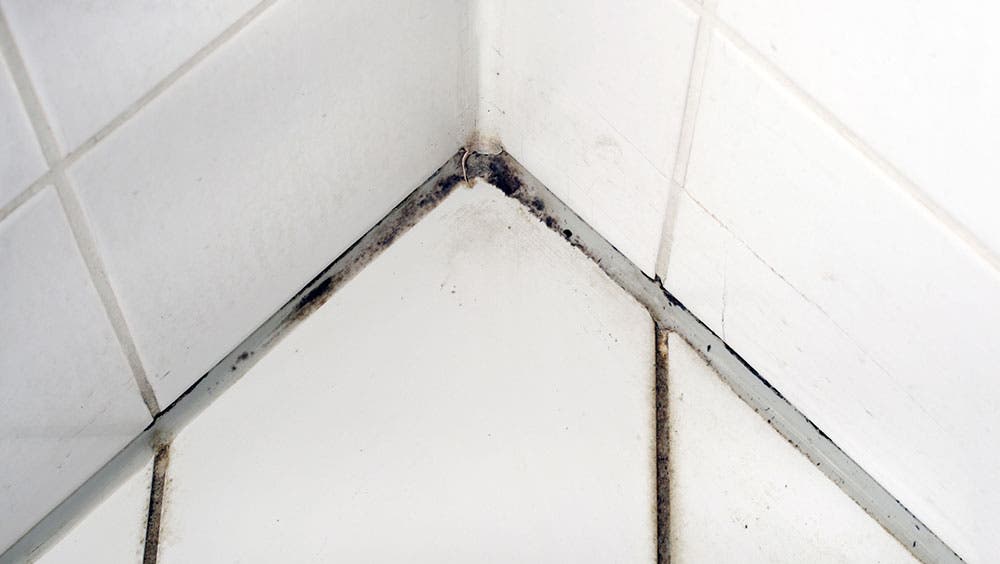
Mold and mildew are fungi that can lead to health issues and make your facility appear dirty
Mold and mildew create an instant “ick” factor in any facility. In addition, inhaling or touching mold can cause allergic reactions or trigger asthma episodes in people with asthma1. Mold and mildew can cause problems for anyone, and allergies to mold are common. It is important to understand what mold and mildew are, how to prevent their growth, and how to treat problems as they arise.
Mold and mildew are both types of fungi, but there are some key differences2:
- Mildew is a type of mold but can only grow on the surfaces of materials (such as grout, glass, and tile). Mildew doesn’t grow inside surfaces, and it is much easier to clean than mold. Mildew can be removed with the right cleaning product. Products that say they are mildewstatic can also help prevent mildew from returning.
- Mold is a fungus that can cause health issues, and allergies to mold are common. Unlike mildew, mold can grow inside structures and porous surfaces like walls and can be harder to remove. Mold on surfaces can be removed like mildew, but mold in walls or in other porous surfaces may require special treatment or even removal and replacement of materials.
In cases where mold and mildew are already present, a disinfectant that kills mold may be necessary to prevent the issue from recurring or spreading. Cleaning may remove the stains and immediate visible mold and mildew but may not be enough to kill the mold and mildew-causing organisms.
Damp, dusty and dirty areas help mold and mildew thrive
Mold and mildew will grow where areas are damp or wet3. The dampness can be in the air from humidity, or on surfaces from leaks or improper drying. In a recent study by the EPA, they found that 85% of US buildings had been exposed to water damage, which means that 85% of buildings in the US may be at high risk of mold problems4. Molds do not need a lot of water to grow; water left from a shower or humidity in the air may be enough. In addition to moisture, mold and mildew need food. If surfaces are dirty, dusty, or greasy, these can be food for mold4. Mold and mildew can thrive in cool and warm temperatures.
Based on these factors, molds and mildew tend to grow well in these areas3,5:
| Bathroom | Water and humidity from showers, and soap scum residue on surfaces provide a great place for mold and mildew |
| Kitchens | Grease and food messes can feed mold and mildew |
| Basements and Crawl Spaces | Cooler temperatures, dampness, dirt and higher likelihood of flooding make these likely spots for mold and mildew |
| Attics | Roof leaks, dust in attics, and warmth in the summer |
Preventing mold and mildew is easier than treating mold and mildew
The best treatment for mold and mildew is to prevent it. Follow these tips to prevent and handle small mold and mildew problems6.
- Before mold appears: Keep humidity in rooms low with appropriate air exchange through HVAC systems. In some climates, you may need dehumidifiers. Keep HVAC filters clean and change regularly. Regularly clean and wipe surfaces dry.
- When you notice some mold or mildew: Use a product designed to kill mold and remove mildew. You can find this information on the product label. Clean the mold and mildew from the surface according to the product instructions. Thoroughly dry the surface after cleaning and removing the mold. Dispose of cloths or towels used to clean the surface to prevent spreading the mold and mildew to other areas.
- After a flood or leak: Thoroughly dry all wet areas with fans. If small areas of mold are present, clean and dry thoroughly. If there is a musty smell after drying, this could indicate a more serious mold issue and you should consult a professional.
Prevent, treat, repeat: Keep mold out of your facility
Mold problems cease to be small when they recur frequently or cover more than 10 square feet of area. Mold is not an issue to ignore. Not all mold problems can be dealt with on your own. For serious, spreading, or recurring mold issues, you may want to consult with a remediation expert. If mold remediation is necessary, it can be extremely expensive: it can cost up to $25 per square foot, and potentially more if fixtures need to be replaced or if a complete remodel is required7. To avoid such expensive remediation, we recommend a prevent, treat, repeat pattern of dealing with mold issues when they first arise.
- Prevent mold and mildew by keeping areas and surfaces dry. You can also help prevent mold and mildew by treating areas with a product that can prevent the growth of mold and mildew.
- Treat mold as it arises with a disinfectant with claims against mold and mildew (not just mold and mildew stains – look for a product that can actually kill mold).
Together, these tips can help protect your facility from mold problems.
References
1. Environmental Protection Agency. (n.d.). Mold and Health. EPA. https://www.epa.gov/mold/mold-and-health
2. LLC, P. (n.d.). Mold vs. mildew: What’s the difference? (everything you need to know). Mold vs. Mildew: What’s the Difference? (Everything You Need to Know). http://silverenvironmental.net/mold-vs-mildew.html
3. Environmental Protection Agency. (n.d.-b). Mold Course Chapter 1. EPA. https://www.epa.gov/mold/mold-course-chapter-1
4. Environmental Protection Agency. (n.d.-c). Summarized Data of the Building Assessment Survey and Evaluation Study. EPA. https://www.epa.gov/indoor-air-quality-iaq/summarized-data-building-assessment-survey-and-evaluation-study
5. LLC, P. (n.d.-a). 9 common causes of mildew in your home (& how to prevent it). 9 Common Causes of Mildew in Your Home (& How to Prevent it). http://www.silverenvironmental.net/prevent-mildew-causes.html
6. Centers for Disease Control and Prevention. (2022, November 14). Homeowner’s and Renter’s Guide to Mold cleanup after disasters. Centers for Disease Control and Prevention. https://www.cdc.gov/mold/cleanup-guide.html
7. Gerhardt, N. (2023, March 3). How much does mold remediation and removal cost?. Forbes. https://www.forbes.com/home-improvement/home/mold-remediation-removal-costs/
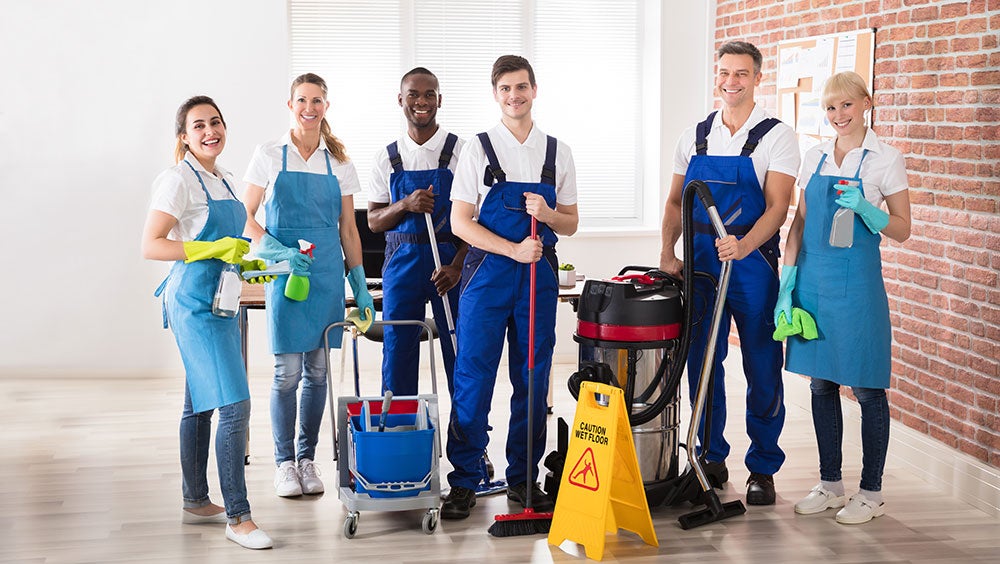
Employee Success, Growth, and Benefits are Part of Sustainability
Primarily, we think of sustainability as only impacting the natural environment. But the natural environment is just one of three pillars of sustainability: environmental, social responsibility, and economic. Together, the three pillars contribute to operating a business that is better for the environment, better for the people in the company and community, and better for long-term economic viability. In this third blog in my sustainability series, I will focus on the social responsibility pillar, in particular, how this translates to your employees and how these investments in your workers may also help your profit.
There are many reasons to invest in the workers you hire. The main reason is, as we evolve as a society and sustainability becomes an important requirement, customers expect that all workers are treated well, given opportunities to advance their careers and are protected from physical hazards at work. Another big reason to invest in your employees is that it will benefit your business. Studies show that worker satisfaction leads to customer satisfaction: happy employees work harder and are more eager to assist customers2. In the case of a cleaning business, a happy employee may attend to special requests from building occupants faster. Investing in your workers can over time reduce your costs, improve worker efficiency, and lead to growth of your business.
Employee Turnover Is a Costly But Preventable Problem in Cleaning Operations
Replacing employees in any organization is costly. Some estimates show that it costs 50 - 200% of the value of a worker’s annual wages to replace them1. Having fewer trained employees in your cleaning organization can limit your ability to take on desired contracts, hindering your business’ growth.
5 Ways to Promote Sustainability and Grow Your Business by Supporting Your Cleaning Workers
- Provide training. On-the-job training not only improves the efficiency and effectiveness of the work janitors do, but it can also encourage workers to stay in a job longer3. Additionally, training can help prevent workplace injuries by teaching proper practices. A good place to start is with online trainings where they can earn a certificate like CloroxPro HealthyClean.
- Provide appropriate PPE and encourage ergonomic practices. Workplace injuries lead to missed shifts and reduced efficiency. This can be prevented by providing appropriate personal protective equipment and encouraging ergonomic working. If your employees’ work requires repetitive motions, over-use injuries may occur, which are challenging to treat. Consider investing in tools that help your workers do their jobs well and limit repetitive motions, such as electrostatic devices. Additionally, consider providing time for stretch breaks and beginning a shift with a warm up.
- Offer career development with opportunities for advancement and pay increases. One main reason many people leave a job is for more money or advancement. If career furthering opportunities are offered to employees, with clear guidelines for when and why a raise or promotion can be expected, they will be encouraged to stay with your business longer as they work towards an advancement goal.
- Encourage feedback and recognize achievements. We evaluate our employees for their performance all the time, but it’s important to also ask them how you could better support them in their jobs and career. One way to do this is to meet with each of them individually every few weeks to hear about the hurdles they encounter in their work. At the same time, it gives you a window into the things they enjoy and what they do well. When you hear about their successes, recognize those achievements and provide encouragement. When providing constructive feedback, make sure it is something they can improve on and ensure they have the tools necessary to make the change.
- Foster a positive and supportive work environment. A positive work culture encourages employees to do and be their best. A happy employee may provide better service to building occupants, so encourage positive recognition, camaraderie, and appreciation in daily work. If you meet with your staff before they start their shift, create time and space to say thank you for their hard work and provide specific examples of great work being done.
Investing in your workforce is a great move to operating more sustainably, it’s also a good choice for growing your business.
References
1. Wigert, S. M. and B. (2023, May 30). This fixable problem costs U.S. businesses $1 trillion. Gallup.com. https://www.gallup.com/workplace/247391/fixable-problem-costs-businesses-trillion.aspx
2. The Economist Newspaper. (n.d.). Why firms should treat their employees well. The Economist. https://www.economist.com/graphic-detail/2019/08/28/why-firms-should-treat-their-employees-well
3. Nauman, S., Bhatti, S., Jalil, F., & Bint E Riaz, M. (2020, November 30). How training at Work Influences Employees’ job satisfaction: Roles of affective commitment and job performance. International Journal of Training Research. https://eric.ed.gov/?id=EJ1313071
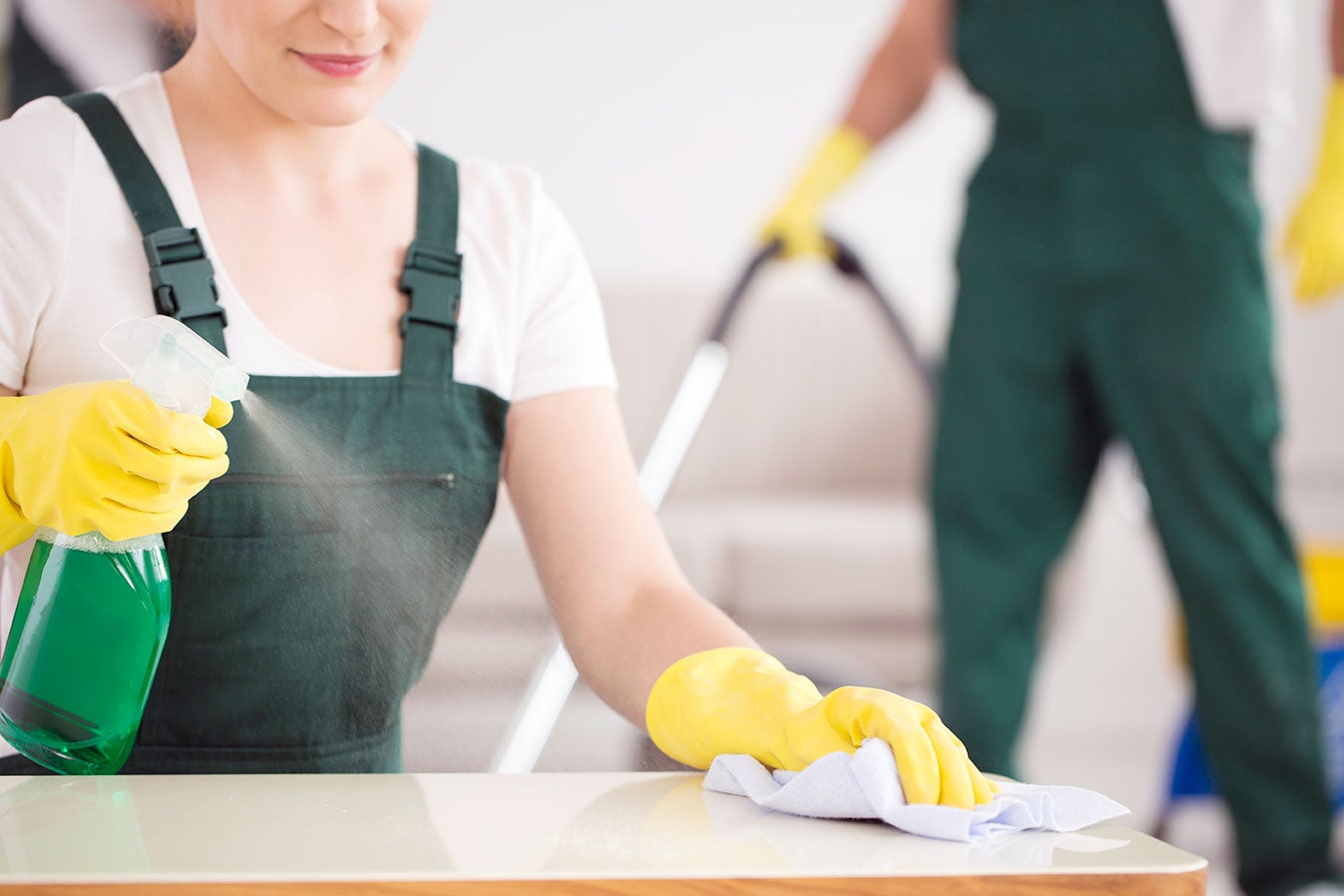
In my previous blog, I covered the products to use in a sustainable cleaning practice. Having the right products is important, but it is also important to use products in a sustainable way. In some cases, the right process will help you avoid using cleaning products at all. In this blog, I will share some processes that help reduce waste so you can clean your facility in a more sustainable way.
The LEED Green Cleaning Policy: A Useful Guide for the Best Practices
The Leadership in Energy and Environmental Design (LEED) certification for green buildings is one of the premier certifications for sustainable buildings. LEED’s experience in operating buildings more sustainably helps companies save energy and money.
LEED certified buildings must have a green cleaning policy that focuses on reducing energy use and waste, using greener products, and using practices that improve the health and well-being of the facility.
Even if you are not contracted with a building that is LEED certified, you can benefit from implementing green cleaning practices. By following the guidelines set forth by LEED, you can create your own Green Cleaning Policy. Simply download their template and use it as a model for your own policy.
5 Areas to Focus On
Based on the guidance in the LEED green cleaning policy, we recommend focusing on these 5 areas to make sustainable changes in your cleaning operation
- Track your product inventory and usage. Keep track of how much product is used. This practice helps with budget planning and allows you to identify any waste. For example, when using a concentrate, make sure you only dilute what is needed for that day, since most concentrates expire within 24 hours of diluting. Also, keep track of product expiration dates to avoid unnecessary disposal of unused products. If you must dispose of an expired product, consider purchasing a smaller quantity of the product next time.
- Where possible, use practices that can help reduce your cleaning tasks. For example, place sticky floor mats at building entrances. This can significantly reduce the amount of dirt and debris tracked into the building, which can reduce the need for frequent floor cleaning. Additionally, encourage building occupants to wipe down their desks and common areas to help prevent the buildup of dried grime, reducing the need for harsh cleaning chemicals. In some cases, using disinfecting wipes instead of microfiber cloths can be beneficial, since it reduces laundering necessary to maintain microfiber, which can save water and energy use in the facility.
- Develop a plan and use checklists. Get to know the surfaces in your facility and how frequently spaces are used. This will enable you to tailor your cleaning plan to meet the specific needs of each space. Identify tasks and spaces that need daily cleaning and disinfection, versus those that only need to be cleaned weekly, quarterly, or as needed. Use checklists to keep track of which areas have been cleaned and when – this can help reduce unnecessary cleaning in spaces that have not been occupied.
- Reduce energy consumption. When possible, use cold water to prepare dilutions or do laundry. Change vacuum filters frequently so they run more efficiently. Use the minimum amount of cleaning and disinfecting product necessary. This may mean selecting disinfectants with the shortest contact time possible. For further guidance on selecting sustainable products, read my previous blog on the subject.
- Invest in training for custodial workers. Sustainability isn’t only about environmental wellness, but also about ensuring the well-being of workers. Training can help enhance your custodial operation improve compliance in processes, help reduce your employee turnover, and improve employee satisfaction. In the end, having more efficient workers who remain in their positions can lead to long-term cost savings for your business. Consider starting with the Clorox HealthyClean training platform for your employees.
Good for the Environment and for Your Business
In a recent survey, facilities said they were willing to pay contractors more for sustainable cleaning practices.1 A separate survey found that when choosing between two contractors, most facility executives would choose the one that offered green cleaning.2 By incorporating the 5 practices presented in this blog, you can establish a sustainability-focused value-added service to your cleaning business that can help you win more bids and benefit your bottom line.
References
1. https://www.cleanlink.com/news/article/Survey-Outlines-BSCFacility-Sustainability-and-ESG-Goals--29192
2. https://www.cleanlink.com/cp/article/Facility-Executives-See-Value-Sustainability-In-Green-Cleaning--21747
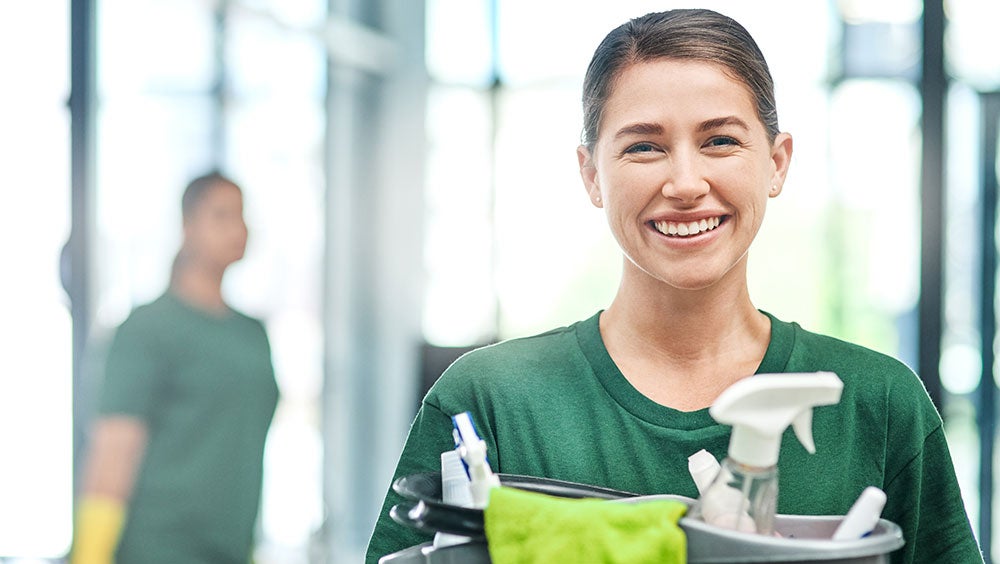
Today, people expect that facilities and cleaning operations use products that are eco-conscious. In one survey, 83% of office workers said they would like to see their company use environmentally friendly cleaning products. It is not just a preference, though. In many places, it is required for facilities to use greener cleaning products. In fact, 90% of U.S. states have a policy about purchasing greener products and in every U.S. state there are universities with sustainability policies2.
Changing the Products You Purchase Is the Easiest Change to Improve Sustainability
Many businesses want to be more environmentally friendly. Whether your facility is seeking LEED certification or looking for ways to use less energy or water, the easiest change to make is to buy different products.
To show why this is true, look at some requirements for LEED certification: the three changes below earn a facility a single point3:
- Implement three strategies for enhanced indoor air quality (strategies include increasing ventilation, ensuring windows are operable or installing permanent entryway systems).
- Replace two product categories that meet VOC content evaluation. Product categories include flooring, ceilings, insulation, and furniture.
- Use cleaning and disinfecting products with a certification such as EPA Design for the Environment and EPA Safer Choice
These first two choices, while important, can be expensive and time-consuming. Clearly, changing the cleaning and disinfecting products you buy is an easy and cost-effective way to help meet your sustainability goals.
Look for Product Certified By an Independent Organization
Even if your facility isn’t trying to achieve LEED certification, it’s important to use products certified by an outside, reliable organization in your sustainable cleaning program. Without it, you can’t be certain that your products meet stringent requirements for sustainability. A recent study showed that products labeled as “Green” that did not have an outside certification were not actually better for the environment than regular products4. In a previous blog post, I talked about several reliable outside (also called third-party) certifications for cleaning and disinfecting products.
EPA Design for the Environment (DfE) (for disinfectants) and EPA Safer Choice (for cleaners and degreasers) are two excellent third-party certifications that are easy to find. You can look for their logos on the products you buy or check their websites for recommended products.
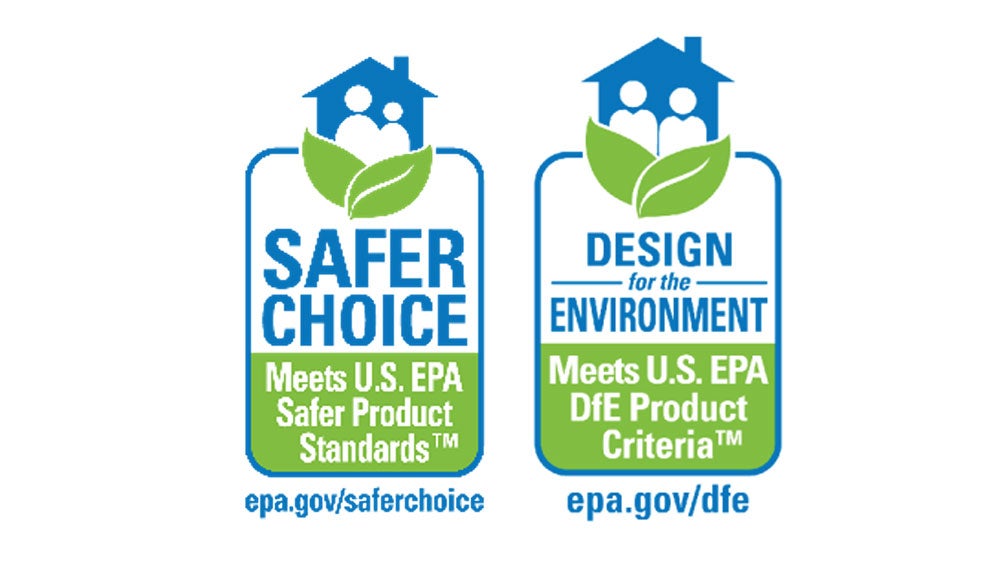
You don’t need a large number of products to get most cleaning jobs done. Using fewer products can make it easier for staff to learn how to use them and can also cut down on waste. These 5 products can accomplish most of what you need, and all of them are available with EPA DfE or Safer Choice certifications.
- Broad-spectrum disinfectant. To kill germs on surfaces that people touch a lot, like doorknobs and tables. Choose one that disinfects quickly (2 minutes or less) to make it easier to effectively kill viruses on surfaces.
- Glass cleaner. Look for one that says “streak-free.” A glass cleaner is important to keep windows and mirrors clean and looking good.
- All-purpose cleaner. A cleaner that can used everywhere to clean visible dirt and soils and help remove dust.
- Neutral floor cleaner. A neutral floor cleaner is good for everyday use to remove dirt and soils. These are made specifically to clean floors without being slippery.
- Degreaser. To clean up tough, greasy messes in places like kitchens. These are stronger than all-purpose cleaners, so you’ll use less of them for the tough jobs.
References
1. Wires, R. P. news. (2007, December 3). Poll: Workers prefer companies with eco-friendly practices. Reliable Plant. Retrieved February 13, 2023, from https://www.reliableplant.com/Read/9363/poll-workers-prefer-companies-with-eco-friendly-practices
2. Bastian, J. (2022, October 12). Sustainability policies for cleaning and disinfection programs. CloroxPro. Retrieved February 13, 2023, from https://www.cloroxpro.com/resource-center/sustainability-policies-for-cleaning-and-disinfection-programs/
3. LEED v4.1 [Internet]. LEED v4.1 | U.S. Green Building Council. [cited 2023Jan30]. Available from: https://www.usgbc.org/leed/v41
4. Gray AD, Miller JA, Weinstein JE. Are Green Household Consumer Products Less Toxic than Conventional Products? An Assessment Involving Grass Shrimp (Palaemon pugio) and Daphnia magna. Environ Toxicol Chem. 2022 Oct;41(10):2444-2453.
5. Maloney B, et al. The environmental footprint of single-use versus reusable cloths for clinical surface decontamination: a life cycle approach. J Hosp Infect. 2022 Dec;130:7-19

EPA lists are designed to guide consumers towards products that are effective against specific pathogens
As you may know, the Environmental Protection Agency (EPA) reviews data submitted by manufacturers for pathogen claims and specific uses. All approved pathogen kill claims and directions for use can be found on EPA master labels, which can be searched on the EPA website (see image below for what this search looks like).
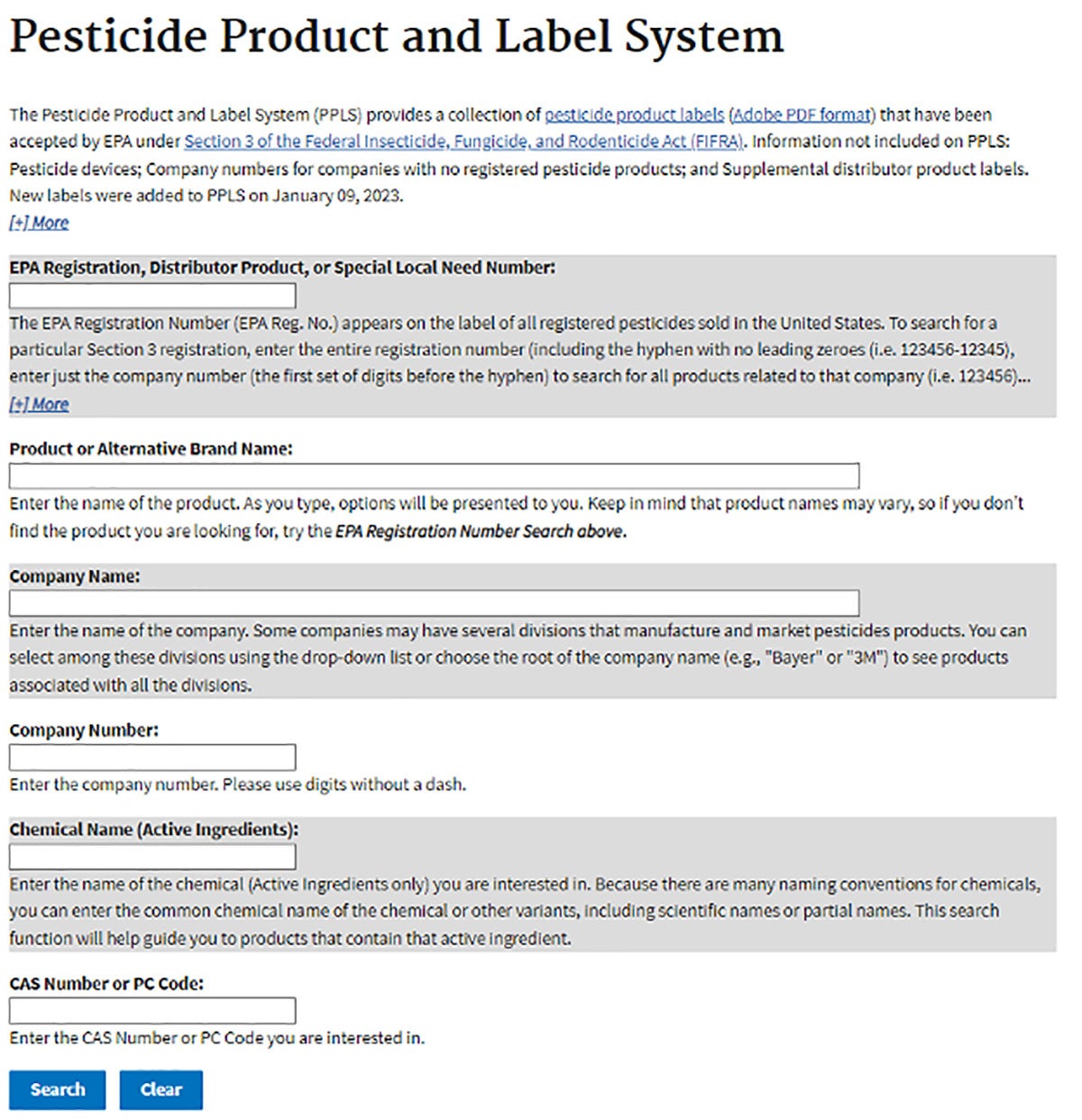
This website allows you to search specific products or chemical active ingredients. However, you cannot use it to search for a product that is effective against a specific pathogen. To do that, you would need to look at the master label for a specific product and see if it is able to kill the pathogen you need to target. This is fine if you already have a product in mind, but in many cases, you may not know what product is effective against a specific pathogen or what product you want to use. To help guide consumers who are concerned about specific pathogens or other product uses, EPA created a number of lists.
Most people became aware of EPA lists during the COVID-19 pandemic, when List N was introduced to guide consumers towards products expected to be effective against SARS-CoV-2 (see image below).
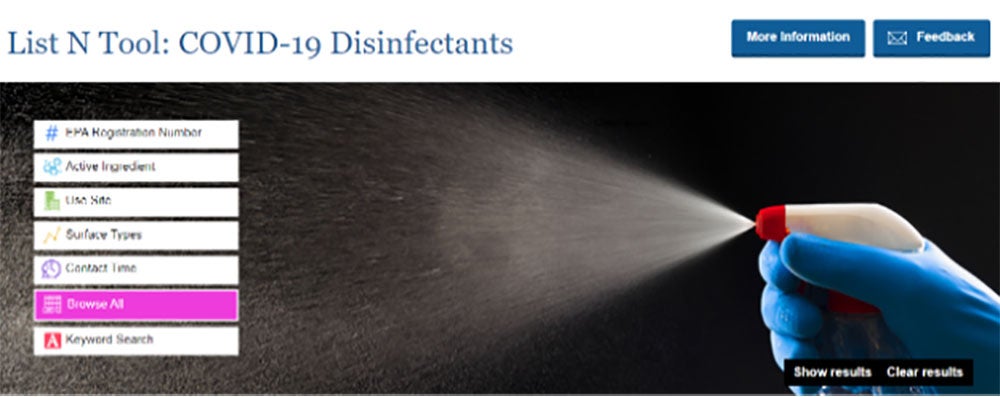
In fact, the EPA has lists to guide effective product choices for the rest of the alphabet, all the way through List Q (except for the letter I).
All these lists are intended to help identify products that are effective for given use. Generally, EPA lists fall into three categories:
- Products registered with the EPA that have disinfection instructions against specific pathogens. Examples: List K for products with claims against Clostridium difficile. Or List G for products with claims against Norovirus. Products on these lists have been tested against these pathogens and have instructions for disinfection against them.
- Products registered with the EPA for specific types of uses. Example: List J for products registered for medical waste treatment. These products have been tested and have verified claims for these uses.
- Emerging viral pathogens lists. These are products that are either have demonstrated, or are expected to be effective against specific pathogens. These include List N for SARS-CoV-2 or List L for Ebola virus. Products on these lists may not have been tested against the pathogen but are expected to be effective because they have claims for harder-to-kill pathogens.
How do products get on one of the EPA’s lists?
These lists are updated periodically by the EPA — it is not an automatic process. This means that there may be products with claims against a pathogen that do not show up on the appropriate list. For the emerging viral pathogens lists (like List N for SARS-CoV-2), eventually, these pathogens may become available for testing by manufacturers. SARS-CoV-2 has been available for testing for over 2 years now, therefore, List N will have products that have been tested and proven against SARS-CoV-2, but it may also have products that have never been tested against the virus but are expected to be effective against it.
What is important to understand is that if the product has disinfection instructions on their master label against a pathogen, it can kill the pathogen, regardless of whether it can be found on the EPA list.
So, should I follow the EPA lists or look for claims on the master label?
That depends on whether you already have a product in mind or whether you are more concerned with a specific pathogen. In some cases, you may already have a specific product that you want to use, or your space may have equipment that can only be treated with specific products. In other cases, you may be concerned about a specific pathogen, as SARS-CoV-2 was a concern for many people, and you want to find which products to use.
Below is some guidance on where to start in either case, but understand that these lists are not intended to help you find an “ideal” disinfectant. They are simply another tool to help you evaluate your product choice!
If you already have a product you want to use and want to know if it kills a specific pathogen of concern:
- Check the product master label for kill claims against this pathogen. Kill claims on a master label have been reviewed and approved by the EPA.
- If your product does not have the kill claim, check the relevant EPA list to see if it is expected to be effective against that pathogen.
If you are concerned about a specific pathogen of concern, but do not know what product to use:
- Check the relevant EPA list to identify products expected to be effective OR
- Reach out to your distributor, product supplier, or product manufacturer and ask them to share which products they have that can kill the pathogen.
EPA lists cannot tell you where you want to go, but they can help you reach your destination!